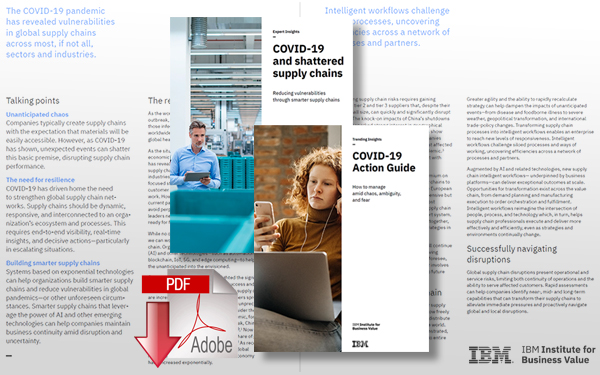How to Leverage Technology to Counter COVID-19 Pandemic Supply Chain Disruptions

In this exclusive interview, Jonathan Wright, Global Head Cognitive Process Re-engineering at IBM, shares his views on a new report on how companies should use technology to leverage emerging patterns during supply chain disruptions.
Preparing for the Next Inevitable Disruption
The current pandemic continues to make a profound impact on the global supply chain – particularly across industries including electronics, auto, pharmaceuticals, metals, and industrials.
While the focus today is on maintaining supply and meeting customer needs, organizations must consider how to react to these ‘black swan’ situations – preparing for the next inevitable disruption.
A new report from the IBM Institute for Business Value, “COVID-19 and Shattered Supply Chains” highlights that the pandemic has revealed vulnerabilities in global supply chains, causing unanticipated chaos while emphasizing a need for resilience and smarter systems based in AI, automation and blockchain technologies.
This calls for organizations to:
- Prepare for when materials are not easily accessible to avoid significant disruption to supply chain performance
- Strengthen global supply chain networks with real-time insights and decisive action, enabling better responsiveness and interconnectedness within an organization’s larger ecosystem
- Root systems in emerging technologies like AI to reduce vulnerabilities, and to maintain business continuity amid disruption
In this exclusive interview, Jonathan Wright, Global Head Cognitive Process Re-engineering at IBM, shares his views on how companies should use technology to leverage emerging patterns during disruption, helping them prepare for future events.
How should companies use technology to leverage emerging patterns during disruption?
We’re seeing disruption now as we’ve never seen it before, and organizations across the board are realizing that they’ll need to shift operating models to maintain the longevity of their business.
As businesses transition to the “new normal,” there should be a significant acceleration of digitization to allow supply chains to emerge in a stronger position.
But that has to start now, with businesses using emerging technologies like AI, blockchain, and IoT to quickly identify patterns in supply and demand to seek out opportunities to these dynamic business challenges.
How can companies get the most out of their responses?
It’s critical that organizations view this as an opportunity to look at demand patterns at a local and global level.
This enables tighter collaboration with logistics partners to better understand how to manage (seems it needs a qualifier on what the “constraints” are; the word “fulfillment” might be what’s missing here so it reads more complete, “…how to manage fulfillment constraints while servicing customers…) constraints while servicing customers with the products they need, where they’re needed most.
How can they best plan for future events like COVID-19?
This pandemic has highlighted cracks and flaws in the system that need to be filled now to get to the other side.
But many of the processes and solutions implemented now should become permanent to help businesses evolve to emerge stronger and better-positioned to service customers – especially in periods of unpredictable, unavoidable disruption.
They should invest in things like hyper-automation to offload some of the more manual, time-intensive tasks – allowing employees to focus on work that is more purposeful and valuable to them.
Where should the focus be?
With AI tackling data gathering and analysis, workers can focus on tasks that are more professionally rewarding while also thinking more critically about what the enterprise needs to maintain business continuity.
Organizations should also consider better risk management of supply chains enabled by hybrid cloud and analysis of external data, allowing for more careful planning and less reactive decision-making.
Finally, they should start to integrate teams around intelligent workflows, helping to realign the business so it’s able to respond quickly to rapidly changing demand signals.
Can you describe IBM’s own supply chain contingency plans and how the company has helped clients in times like these?
We are not discussing our supply chain status at this time. IBM has launched a company-wide Coronavirus response, which is making some of the company’s key supply chain offerings available at no charge for 90 days including IBM Sterling’s Inventory Visibility, Supply Chain Business Network, Connect and Control Center Director, and Supply Chain Insights with Watson. The IBM resource page can be found here.
What specific benefits are included here?
These offerings help enable;
- Demand Sensing for critical products and regions to generate shipment forecasts factoring COVID-19 progression and the impact on consumer spending
- Supply Decisioning to visualize potential hotspots for supply base disruptions
- Inventory Visibility & Emergency Supplier Onboarding to accelerate trusted supplier onboarding for non-traditional suppliers with inventory availability for buyer/supplier matching, and
- Inventory Control Tower to help rapidly identify risks and recommending best action with a view of supply and demand correlated with external data (e.g. weather) and AI-driven insights.
Related Article: COVID-19 Disruption Removes Decades of Supply Chain Inertia – Now What?
Related Papers
COVID-19 and Shattered Supply Chains + Action Guide
This report takes a deep dive into how COVID-19 has driven home the need to reduce global supply chain vulnerabilities through intelligent workflows, additionally, it provides details on how the global community must come together to face the coronavirus disease crisis. Download Now!
8 Keys to Achieving Success with Artificial Intelligence in Supply Chain
This white paper looks at the fundamentals that supply chains need in place in order to achieve real results from Artificial Intelligence implementations. Download Now!
More Resources on Coronavirus COVID-19
Article Topics
IBM News & Resources
Creating Business Value With Embedded Sustainability The Circular Supply Chain with Lisa Dender, Global Lead for Product Chemical Regulations at IBM Talking Supply Chain Podcast: On the Road at MHI with Noelle Russell Cultivating Relentless Supply Chain Agility at IBM The Retail Supply Chain is Hot Hot Hot The Rebound Podcast: We’re Going to Need a Bigger Boat? New IBM study addresses trucking’s future through a digital transformation More IBMLatest in Supply Chain
U.S. Manufacturing is Growing but Employment Not Keeping Pace The Two Most Important Factors in Last-Mile Delivery Most Companies Unprepared For Supply Chain Emergency Microsoft Unveils New AI Innovations For Warehouses Let’s Spend Five Minutes Talking About ... Malaysia Baltimore Bridge Collapse: Impact on Freight Navigating TIm Cook Says Apple Plans to Increase Investments in Vietnam More Supply ChainAbout the Author


















